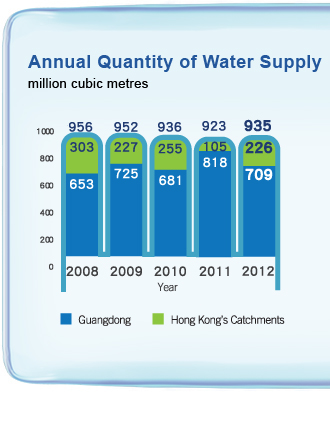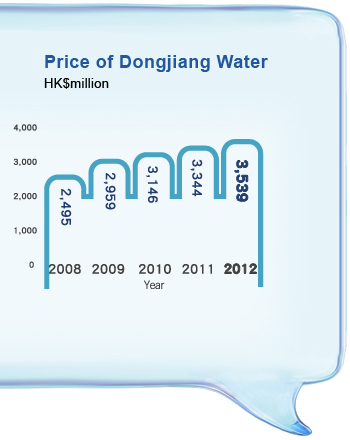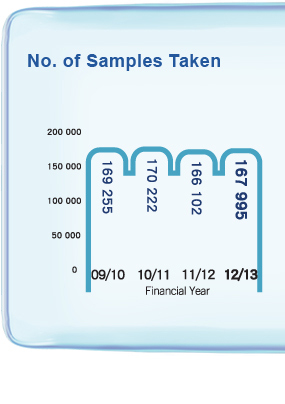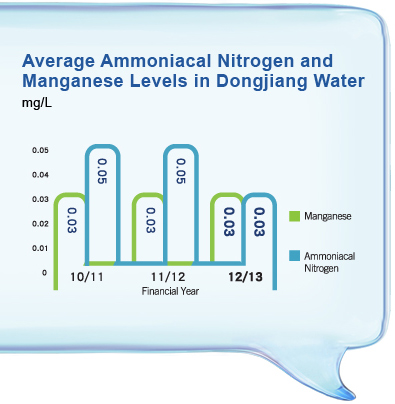

| We are focusing on the future: optimising water supplies, developing alternative sources of fresh water and investing in existing and new infrastructure. |
| TOTAL WATER MANAGEMENT STRATEGY |

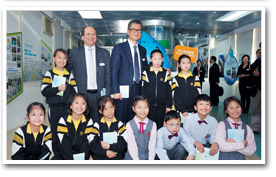
|
Hong Kong, as a global centre of business and finance, relies
on secure water supplies for its sustainable development.
Whilst we currently have reliable and consistent water
resources to draw down, we recognise the need to prepare for
extreme scenarios that may occur in the future. Preparations
include strengthened demand management initiatives and
the exploration of new technologies to develop additional
water resources cost effectively. The Total Water Management
Strategy, introduced by Government in 2008, has provided a
firm foundation for us to build on. In line with the strategy, we
have enhanced public education on water use and savings,
limited water loss along the distribution system and extended
the salt water supply system. We will appoint consultants to
review the progress made under the strategy and to indicate
any necessary new directions or refinements.
|
| SECURING WATER RESOURCES | |
|
The Dongjiang (or East River) in Guangdong together with a network of domestic rainwater catchments located across Hong Kong's extensive country parks and rural areas, continues to meet fresh water requirements. We are supplementing and conserving our fresh water resources by using sea water for toilet flushing and through a small but growing amount of recycled water used in estate cleaning, irrigation and landscaping.
In 2012, 76 per cent of raw fresh water was transported by a dedicated aqueduct from the Dongjiang River. This is less than the 89 per cent take down from the Dongjiang recorded over the previous year. Apart from when the aqueduct is closed for annual maintenance, the daily supply from this source is only slightly less than the city's daily consumption. Imported Dongjiang water that is surplus to immediate needs is stored with locally collected raw water in Plover Cove impounding reservoir. The seawater used in toilet flushing is extracted by pumping stations located at various points along Hong Kong's water front and distributed to 80 per cent of Hong Kong's population. The Department is developing a viable long term supply strategy based on the predicted water resources needed by both Hong Kong and the neighbouring Pearl River Delta. As a result, we continue to explore alternative sources of both potable and non-potable water to maintain a suitable level of reliance on the Dongjiang. |
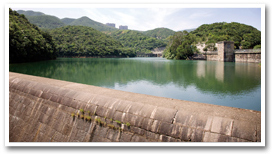
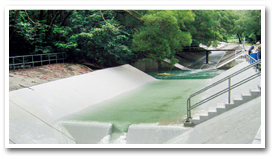
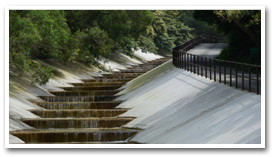
|
| FRESH WATER FROM DONGJIANG | ||
|
||
|
The supply agreement that covers the Dongjiang takes into account both Hong Kong's needs and the ongoing water supply status within the Pearl River Delta. The ultimate quantity stipulated in the current water supply agreement with Guangdong means that the supply of water from the Dongjiang is sufficient to meet Hong Kong's estimated demand through to 2030 and beyond, as long as there is no acute water shortage in the Pearl River Delta area. Actual draw down is determined on a monthly basis taking into account seasonal rainfall. This optimises the overall use of water resources. The existing three-year agreement, signed at the end of 2011, sets the cost of the water at $3,539 million for 2012, $3,743 for 2013 and $3,959 for 2014. This price regime takes into account the substantial appreciation of China's RMB against the Hong Kong dollar and escalating rates of inflation in Guangdong and Hong Kong. Although the purchase costs are higher than pre-2009 charges, they have not been reflected in any increase in water charges to consumers to date. We have developed a strong partnership and enjoy close communications with the Guangdong authorities regarding mutual water requirements. By controlling storage levels in Hong Kong's impounding reservoirs, we minimise local water waste and optimise pumping costs. Together with the Guangdong authorities, we oversee water transfer operations and ensure a high degree of transparency in these operations and vigilance in terms of water quality and security. The Guangdong authorities have implemented measures to protect the Dongjiang's water environment and to ensure that the quality of water pumped to Hong Kong meets the relevant national environmental quality standards for surface water. These measures include new sewage treatment plants, removal of polluting factories and continual operating the bio-nitrification plant at the Shenzhen Reservoir as needed. Relevant laws and instructions have been enacted in Guangdong to maintain quality standards. |
||
| Bio-nitrification plant of Dongjiang water supply in mainland |
||||||
|
|
||||||
| Pumping station of Dongjiang water supply in mainland |
||||||
|
A dedicated aqueduct directly transfers river water from the Dongjiang intake to the Shenzhen Reservoir, bypassing possible pollution sources along the supply route. This also enables us to keep treatment costs for fresh water supplies low while maintaining a consistently high level of water quality for consumers. These works are being overseen by members of Hong Kong's Advisory Committee on Water Resources and Quality of Water Supplies (ACRQWS) who undertake visits to water pollution control facilities within the Dongjiang catchment as well as the supply system itself. The findings and observations by the committee's members who are drawn from the fields of academia, medicine and law as well as Government departments, district councils and green groups, are reported at media briefings and help to maintain public confidence. A visit conducted in November 2012 enabled members to see firsthand the supply system that takes our water from the city of Heyuan to Shenzhen. |
| DOMESTIC CATCHMENTS |
|
Designated water catchment areas cover 30 per cent of Hong Kong's land area. Rainwater collected from these catchments is stored in 17 impounding reservoirs across the territory. Although collected water is largely uncontaminated, the Department has undertaken protection measures along the collection system with regular inspections, maintenance and the removal of debris.
|
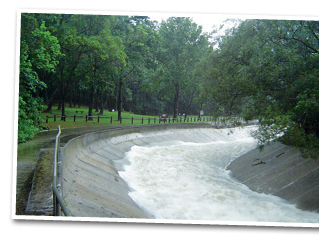 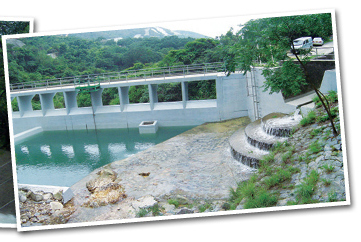 |
| QUALITY AND HEALTH STANDARDS |
|
A comprehensive programme involving physical, chemical, radiological, biological and bacteriological testing is applied throughout the collection, treatment and supply processes of water, irrespective of whether it is sourced from the Dongjiang or is collected from within the territory's catchment areas. Samples are taken regularly from both pre-determined and randomly selected points along the supply chain and analysed using advanced and proven technologies with rigorous quality assurance protocols. From August 2012, the Department applied the updated WHO Guidelines for Drinking-water quality (WHO 2011). Hong Kong is in full compliance. Analytical techniques and equipment used in our laboratories are continuously enhanced and upgraded. Advances, including a new collision cell technique used to detect trace metals in water and an automated imaging particle analysis system which quickly assess the algal population have enhanced water quality monitoring. |
|
On-line Water Quality Monitoring Systems at Muk Wu Pumping Station, Plover Cove Reservoir, Shing Mun Reservoir and Tai Lam Chung Reservoir continue to gauge the quality of the water we receive from the Dongjiang and the water we store in reservoirs. In addition, our Supervisory Control and Data Acquisition (SCADA) system will be extended to include an on-line water quality analyser being set up in phases at our impounding reservoirs. The first, Shek Pik Reservoir, is pending commission.
|
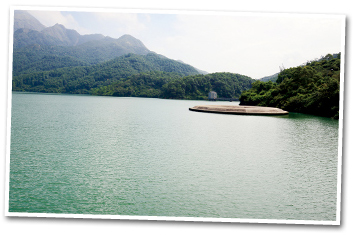 |
||
|
|||
|
|
Radiological monitoring is routinely carried out to ensure the safety of our supplies of drinking water. In April 2012, the department participated in an inter-departmental Daya Bay Contingency Plan (DBCP) excercise to test emergency response, staff deployment and support. We are confident that all radiological monitoring systems continue to protect the quality and safety of Hong Kong's fresh water.
|
|
The Department has also developed an innovative and highly efficient Biosensing Alert System using zebrafish to monitor hazardous materials that may appear in the water supply. Zebrafish have a genetic similarity to humans and are closely monitored in tanks with advanced video recorders and computer programmes. By analysing abnormalities in the activity and distribution of zebrafish, water contamination can be detected. The system alerts staff members automatically by SMS, emails and phone calls and collects water samples for rapid testing using bioluminescence technology. Highly accurate and sensitive, the technology can identify thousands of different hazardous materials within 60 minutes at a low cost of about $50 per sample.
Details about the quality of both the Dongjiang water and our overall drinking water supply are available for public viewing on the Department's website http://www.wsd.gov.hk.
| FRESHWATER ALTERNATIVES | |
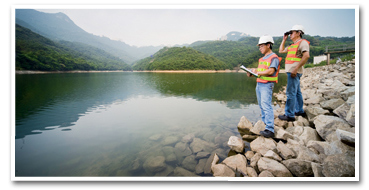
|
Economic and sustainable alternative water resources are required to meet long term demand and, if possible, reduce our draw down from the Dongjiang River. We continue to explore options and adopt solutions that will lessen the stress on regional resources and enable us to conserve as much fresh water as possible.
|
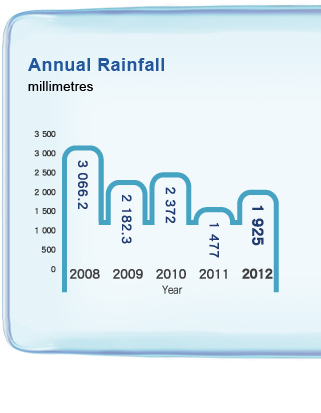 |
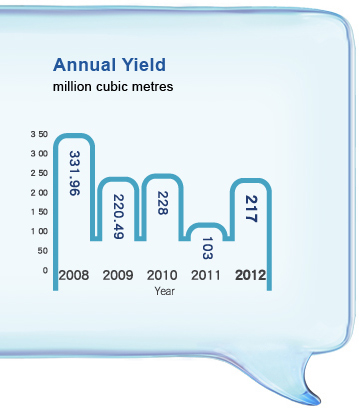 |
| Moving forward with Desalination |
Desalination, using reverse osmosis technology to produce
potable water that complies with WHO Guidelines for Drinking-water
Quality, is a promising water resource for Hong Kong. We
have reserved a site of about 10 hectares at Tseung Kwan O
Area 137 for the construction of a desalination plant with an initial
output capacity of 50 million cubic metres per annum. Plans
include provisions for future expansion to an ultimate capacity of
90 million cubic metres per annum. This will meet about 10 per
cent of Hong Kong's fresh water demand.
|
|||
|
Planning and investigation studies are underway and scheduled for completion by the end of 2014. The studies cover detailed feasibility, preliminary design and a cost-effectiveness analysis. Subject to the findings and recommendations of the study, we plan to seek further funding for detailed investigation, design and subsequent construction of the desalination plant at a time that will be dictated by demand and supply trends. We will also undertake a public engagement exercise next year. Given the current situation, we envisage a commissioning date of 2020.
|
|||
| Use of Recycled Water | |||
|
Pilot schemes for the recycling of treated effluent in Ngong Ping, Lantau and She Wu Hui Sewage Treatment Works have demonstrated that the use of reclaimed water for non-potable applications is technically feasible. An inter-departmental working group is exploring the details of producing and supplying reclaimed water. Concerted planning work is underway and we anticipate providing recycled water to residents in Sheung Shui, Fanling and the North East New Territories New development Areas for toilet flushing and other non-potable uses by around 2021.
|
|
||
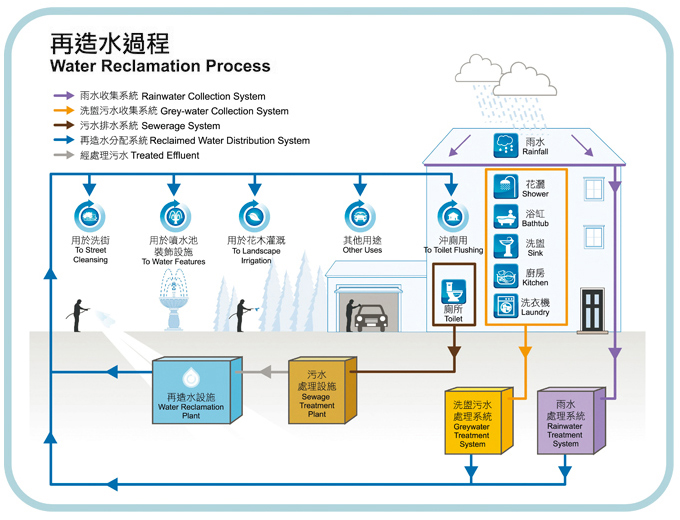
|
|||
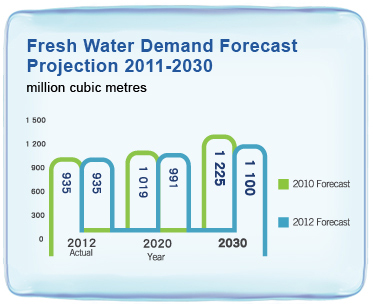 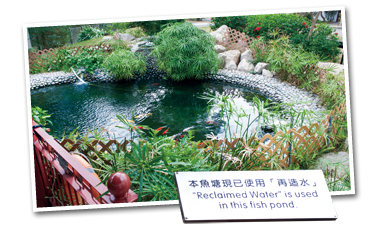 |
Lower quality water collected from baths, shower, wash basins and kitchen sinks is known as grey water. Along with harvested rainwater these supplies can be treated and reused as non-potable water for toilet flushing and irrigation. We have established technical and quality standards as well as a code of practice and guidelines for use of these supplies in Hong Kong. We are encouraging private developers to implement grey water recycling and rain harvesting into their developments. Government projects will also incorporate grey water and rainwater harvesting systems. An innovative water resource management system that integrates freshwater, seawater and reclaimed grey water into a low-cost Triple Water Supply (TWS) system has been developed by the Department in partnership with the Airport Authority Hong Kong, the Hong Kong University of Science and Technology and Delft University in The Netherlands. The system is currently in use at Hong Kong International Airport and has reduced the airport's fresh water demand by 52 per cent. |
|
|
|||
| Dongjiang water pipes | |||
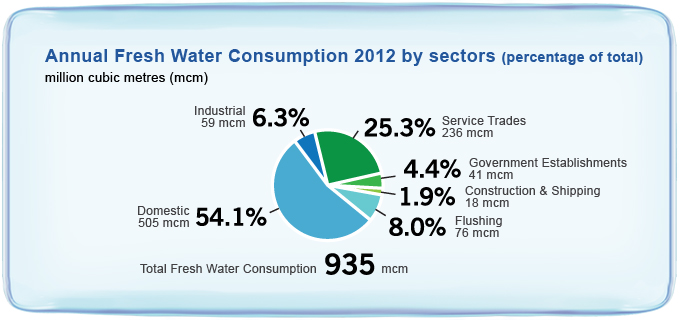
| Annual Fresh Water Consumption (by sectors) |
| million cubic metres |
|


